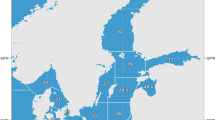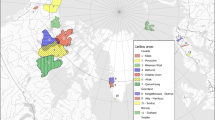Abstract
Concentrations of perfluorooctanesulfonate (PFOS) and several other perfluoroalkyl surfactants (PASs) were determined in nine major water bodies (n = 51) of New York State (NYS). These PASs were also measured in the livers of two species of sport fish (n = 66) from 20 inland lakes in NYS. Finally, perfluorinated compounds were measured in the livers of 10 species of waterfowl (n = 87) from the Niagara River region in NYS. PFOS, perfluorooctanoic acid (PFOA), and perfluorohexanesulfonate (PFHS) were ubiquitous in NYS waters. PFOA was typically found at higher concentrations than were PFOS and PFHS. Elevated concentrations of PFOS were found in surface waters of Lake Onondaga, and elevated concentrations of PFOA were found in the Hudson River. PFOS was the most abundant perfluorinated compound in all fish and bird samples. PFOS concentrations in the livers of fishes ranged from 9 to 315 ng/g wet weight. PFOS, PFOA, and PFOSA (perfluorooctanesulfonamide) concentrations in smallmouth and largemouth bass (taken together) caught in remote mountain lakes with no known point sources of PAS contamination were 14 to 207, < 1.5 to 6.1, and < 1.5 to 9.8 ng/g wet weight, respectively. PFOS concentrations in the livers of birds ranged from 11 to 882 ng/g wet weight. PFOS concentrations were 2.5-fold greater (p = 0.001) in piscivorous birds than in non-piscivorous birds. However, PFOA, PFOSA, and PFHS were not found in bird livers. Overall, average concentrations of PFOS in fish were 8850-fold greater than those in surface water. An average biomagnification factor of 8.9 was estimated for PFOS in common merganser relative to that in fish. This study highlights the significance of dietary fish in PFOS accumulation in the food chain. Furthermore, our results provide information on the distribution of PASs in natural waters, fish, and several bird species in NYS.






Similar content being viewed by others
References
Anderson BW, Timken RL (1971) Age and sex characteristics of common mergansers. J Wildlife Manag 35:388–393
Bellrose FC (1980) Ducks, Geese and swans of North America, third edition. Stackpole Books, Harrrisburg, Pennsylvania, 540 pp
Boulanger B, Vargo J, Schnoor JL, Hornbuckle KG (2004) Detection of perfluorooctane surfactants in Great Lakes water. Environ Sci Technol 38:4064–4070
Canadian Wildlife Service and U.S. Fish and Wildlife Service (1977) North American bird banding techniques, volume II, part 6. Environmental Management Service, Fisheries and Environment Canada
Ellis DA, Martin JW, De Silva AO, Mabury SA, Hurley MD, Anderson MPS, Wallington TJ (2004) Degradation of fluorotelomer alcohols: a likely atmospheric source of perfluorinated carboxylic acids. Environ Sci Technol 38:3316–3321
Giesy JP, Kannan K (2001) Global distribution of perfluorooctane sulfonate and related perfluorinated compounds in wildlife. Environ Sci Technol 35:1339–1342
Giesy JP, Kannan K (2002) Perfluorochemical surfactants in the environment. Environ Sci Technol 36:147A–152A
Hansen KJ, Clemen LA, Ellefson ME, Johnson HO (2001) Compound-specific, quantitative characterization of organic fluorochemicals in biological matrices. Environ Sci Technol 35:766–770
Henry KS, Kannan K, Nagy BW, Kevern NR, Zabik MJ, Geisy JP (1998) Concentrations and hazard assessment of organochlorine contaminants and mercury in smallmouth bass from a remote lake in the upper peninsula of Michigan. Arch Environ Contam Toxicol 34:81–86
Kannan K, Koistinen J, Beckman K, Evans T, Gorzelany JF, Hansen KJ, Jones PD, Helle E, Nyman M, Giesy JP (2001) Accumulation of perfluorooctane sulfonate in marine mammals. Environ Sci Technol 35:1593–1598
Kannan K, Choi J, Iseki N, Senthilkumar K, Kim DH, Masunaga S, Giesy JP (2002a) Concentrations of perfluorinated acids in livers of birds from Japan and Korea. Chemosphere 49:225–231
Kannan K, Newsted J, Halbrook RS, Giesy JP (2002b) Perfluorooctanesulfonate and related fluorinated hydrocarbons in mink and river otters from the United States. Environ Sci Technol 36:2566–2571
Kannan K, Corsolini S, Falandysz J, Fillman G, Kumar KS, Loganathan BG, Mohd MA, Olivero J, Wouwe NV, Yang JH, Aldous KM (2004) Perfluorooctanesulfonate and related fluorochemicals in human blood from several countries. Environ Sci Technol 38:4489–4495
Kannan K, Tao L, Sinclair E, Pastva SD, Jude DJ, Giesy JP (2005) Perfluorinated compounds in aquatic organisms at various trophic levels in a Great Lakes food chain. Arch Environ Contam Toxicol 48:559–566
Kennedy GL, Butenhoff JL, Olsen GW, O’Connor JC, Seacat AM, Perkins RG, Biegel LB, Murphy SR, Farrar DG (2004) The toxicology of perfluorooctanoate. Crit Rev Toxicol 34:351–384
Martin JW, Maybury SA, Solomon KR, Muir DCG (2003) Bioconcentration and tissue distribution of perfluorinated acids in rainbow trout. Environ Toxicol Chem 22:196–204
Newell AJ, Johnson DW, Allen LK (1987) Niagara river biota contamination project: fish flesh criteria for piscivorous wildlife. Technical report 87-3. Division of Fish and Wildlife, Bureau of Environmental Protection, NYS DEC
Newsted JL, Beach S, Gallagher S, Giesy JP (2004) The acute and chronic effects of perfluorooctanesulfonate (PFOS) to mallards (Anas platyrhynchos). SETAC 2004 poster
Onondaga County Department of Water Environment Protection website http://www.lake.onondaga.ny.us/ol11.htm
Seacat AM, Thoinford PJ, Hansen KJ, Olsen GW, Case MT, Butinhoff JL (2002) Subchronic toxicity studies on potassium perfluorooctane sulfonate in cynomolgus monkeys. Tox Sci 68:249–264
So M, Taniyasi S, Yamashita N, Giesy J, Zheng J, Fang Z, Im S, Lam PKS (2004) Perfluorinated compounds in costal waters of Hong Kong, South China and Korea, Environ Sci Technol 38:4056–4063
Taniyasu S, Kannan K, Horii Y, Hanari N, Yamashita N (2003) A survey of perfluorooctane sulfonate and related perfluorinated organic compounds in water, fish, birds and humans in Japan. Environ Sci Technol 37:2634–2639
Tomy GT, Budakowski W, Halldorson T, Helm PA, Stern GA, Friesen K, Pepper K, Tittlemier SA, Fisk AT (2004) Fluorinated organic compounds in the eastern arctic marine food web. Environ Sci Technol 38:6475–6481
Wang N, Szostek B, Folsom PW, Sulecki LM, Capka V, Buck RC, Berti WR, Gannon JT (2005) Aerobic biotransformation of 14C-labelled 8-2 telomer alcohol by activated sludge from a domestic sewage treatment plant. Environ Sci Technol 39:531–538
Yamashita N, Kannan K, Taniyasu S, Horii Y, Okazawa T, Petrick G, Gamo T (2004) Analysis of perfluorinated acids at parts-per- quadrillion levels in seawater using liquid chromatography-tandem mass spectrometry. Environ Sci Technol 38:5522–5528
Acknowledgments
The authors wish to thank Jefferey Loukmas, New York State Department of Environmental Conservation, for providing fish samples and information regarding fish. We thank Erik Latremore and Dustin Edwards for collecting fish and processing tissues and Larry Skinner and Howard Simonin (all with NYSDEC) for assistance with the fish collections. Fish samples were collected as part of a New York State Energy and Research and Development Authority (NYSERDA) grant. Funding for the collection of waterfowl and dietary analysis was provided under Federal Aid for the Restoration of Wildlife to New York State, Project WE-173-G. We thank T. Martin, assisted by J. Curtiss, T. Forti, C. Brown, M. Kandel, J. Rogers and D. Seyler in the field and G. Kimber, M. Levendusky and C. Dean in the laboratory, for collection and processing of waterfowl during 1994-1996. We thank A. Bathrick, K. Hellijas, and K. Geesler for the processing of waterfowl collected during 1999/2000; M. A. Ellis for diet analysis; and S. Fonda, N. Wright, B. Bidwell, and S. Reese for data management. We thank all waterfowl hunters who donated birds, and J. Daniels, who volunteered to solicit birds from hunters and to maintain duck traps for the study.
Author information
Authors and Affiliations
Corresponding author
Rights and permissions
About this article
Cite this article
Sinclair, E., Mayack, D.T., Roblee, K. et al. Occurrence of Perfluoroalkyl Surfactants in Water, Fish, and Birds from New York State. Arch Environ Contam Toxicol 50, 398–410 (2006). https://doi.org/10.1007/s00244-005-1188-z
Received:
Accepted:
Published:
Issue Date:
DOI: https://doi.org/10.1007/s00244-005-1188-z




